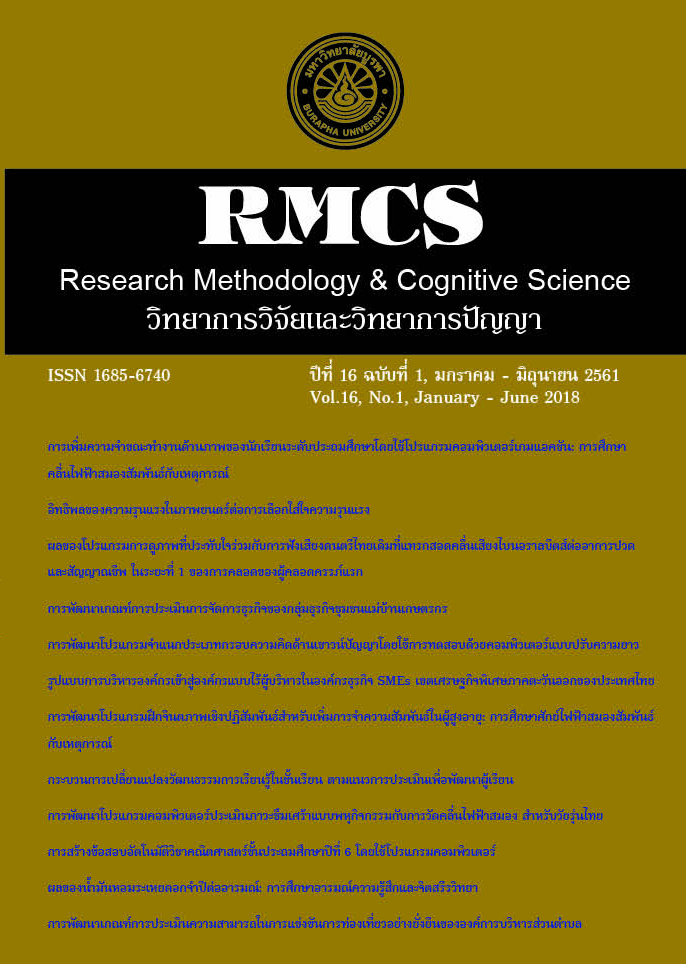Effect of Michelia (Jumpee) Oil on Emotion: Emotional State and Psychophysiological Parameters Approach
Main Article Content
Abstract
Jumpee (Michelia alba), a native Thai plant, is a fragrant flower. The important chemical composition that was found when extracted by steam distillation is linalool. The substance is similar to the chemical compound that found in lavender oil. The previous research has found that Lavender oil stimulated the inhaler to feel pleasant, satisfied, relaxed, helps to recovery mental state, stress, and anxiety. Researchers were interested to study whether jumpee oil can stimulate feelings of pleasantness, satisfaction and relaxation as lavender oil. Experimental study was performed with 23 participants. This study aimed to compare a pleasantness effect and arousal effect of jumpee oil versus lavender oil, civet oil, and sunflower oil (control oil). Mood changes of emotional state and physiological parameters were measured. A statistical analysis of one-way repeated analysis of variance was performed.
The findings were showed that jumpee oil induced the inhaler to feel pleasant by reducing the low frequency / high frequency ratio of the heart rate variability and stimulated a feeling of arousal by increasing the skin conductance response at a significant level of .05. The results of this study was a useful information for using aromatic flowers, jumpee, to improve mood. However, for better support information, further research should study the effect of jumpee oil on other physiological responses such as electromyography of electroencephalogram (brain waves).
Article Details
References
Bensafi, M., Rouby, C., Farget, V., Bertrand, B., Vigouroux, M., & Holley, A. (2002). Autonomic nervous system responses to odours: The role of pleasantness and arousal. Chemical Senses, 27(8), 703-709. https://doi.org/10.1093/chemse/27.8.703
Bradley, M. M., & Lang, P. J. (1994). Measuring emotion: the Self-Assessment Manikin and the Semantic Differential. Journal of Behavior Therapy and Experimental Psychiatry, 25(1), 49-59.
Bradley, M. M., & Lang, P. J. (2000). Measuring emotion: Behavior, feeling, and physiology. In Cognitive neuroscience of emotion(pp. 242-276). New York, US: Oxford University Press.
Cacioppo, J. T., Tassinary, L. G., & Berntson, G. G. (Eds.). (2007). Handbook of psychophysiology (3rd ed.). New York: Cambridge University Press.
Croy, I., Lange, K., Krone, F., Negoias, S., Seo, H.-S., & Hummel, T. (2009). Comparison between odor thresholds for phenyl ethyl alcohol and butanol. Chemical Senses, 34(6), 523-527. https://doi.org/10.1093/chemse/bjp029
Delplanque, S., Grandjean, D., Chrea, C., Aymard, L., Cayeux, I., Le Calvé, B., … Sander, D. (2008). Emotional processing of odors: evidence for a nonlinear relation between pleasantness and familiarity evaluations. Chemical Senses, 33(5), 469-479. https://doi.org/10.1093/chemse/bjn014
Effati-Daryani, F., Mohammad-Alizadeh-Charandabi, S., Mirghafourvand, M., Taghizadeh, M., & Mohammadi, A. (2015). Effect of lavender cream with or without foot-bath on anxiety, stress and depression in pregnancy: a randomized placebo-controlled trial. Journal of Caring Sciences, 4(1), 63-73. https://doi.org/10.5681/jcs.2015.007
Ferdenzi, C., Schirmer, A., Roberts, S. C., Delplanque, S., Porcherot, C., Cayeux, I., … Grandjean, D. (2011). Affective dimensions of odor perception: A comparison between Swiss, British, and Singaporean populations. Emotion, 11(5), 1168-1181. https://doi.org/10.1037/a0022853
Kadohisa, M. (2013). Effects of odor on emotion, with implications. Frontiers in Systems Neuroscience, 7. https://doi.org/10.3389/fnsys.2013.00066
Kianpour, M., Mansouri, A., Mehrabi, T., & Asghari, G. (2016). Effect of lavender scent inhalation on prevention of stress, anxiety and depression in the postpartum period. Iranian Journal of Nursing and Midwifery Research, 21(2), 197-201. https://doi.org/10.4103/1735-9066.178248
Kumar, D., Kumar, S., Taprial, S., Kashyap, D., Kumar, A., & Prakash, O. (2012). A review of chemical and biological profile of genus MicheliaJournal of Chinese Integrative Medicine, 10(12), 1336-1340. https://doi.org/10.3736/jcim20121203
Malik, M., Camm, A. J., Bigger, J. T., Breithardt, G., Cerutti, S., Cohen, R. J., … Singer, D. H. (1996). Heart rate variability. Standards of measurement, physiological interpretation, and clinical use. European Heart Journal, 17(3), 354-381.
Maxwell, S. E., & Delaney, H. D. (2004). Designing experiments and analyzing data: a model comparison perspective (2nd ed.). Mahwah, New Jersey: Lawrence Erlbaum Associates.
Millot, J.-L., Brand, G., & Morand, N. (2002). Effects of ambient odors on reaction time in humans. Neuroscience Letters, 322(2), 79-82.
Pensuk, W., Padumanonda, T., & Pichaensoonthon, C. (2007). Comparison of the chemical constituents in michelia alba flower oil extracted by steam distillation, hexane extraction and enfleurage method. Journal of Thai Traditional & Alternative Medicine, 5(1) 30-39.
Price, S., & Price, L. (2007). Aromatherapy for health professionals. Edinburgh: Churchill Livingstone.
Sakamoto, R., Minoura, K., Usui, A., Ishizuka, Y., & Kanba, S. (2005). Effectiveness of aroma on work efficiency: lavender aroma during recesses prevents deterioration of work performance. Chemical Senses, 30(8), 683-691. https://doi.org/10.1093/chemse/bji061
Sequeira, H., Hot, P., Silvert, L., & Delplanque, S. (2009). Electrical autonomic correlates of emotion. International Journal of Psychophysiology: Official Journal of the International Organization of Psychophysiology, 71(1), 50-56. https://doi.org/10.1016/j.ijpsycho.2008.07.009

